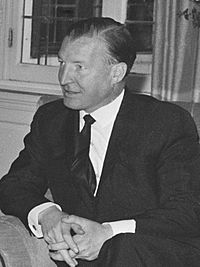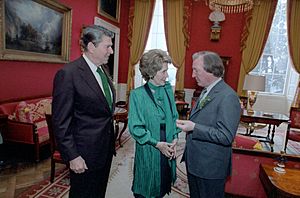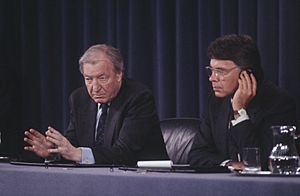Charles Haughey facts for kids
Quick facts for kids
Charles Haughey
|
|
|---|---|
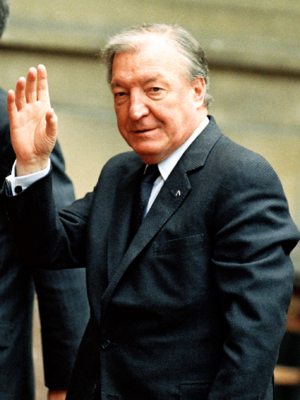
Haughey in 1989
|
|
| 7th Taoiseach | |
| In office 10 March 1987 – 11 February 1992 |
|
| President | |
| Tánaiste |
|
| Preceded by | Garret FitzGerald |
| Succeeded by | Albert Reynolds |
| In office 9 March 1982 – 14 December 1982 |
|
| President | Patrick Hillery |
| Tánaiste | Ray MacSharry |
| Preceded by | Garret FitzGerald |
| Succeeded by | Garret FitzGerald |
| In office 11 December 1979 – 30 June 1981 |
|
| President | Patrick Hillery |
| Tánaiste | George Colley |
| Preceded by | Jack Lynch |
| Succeeded by | Garret FitzGerald |
| Minister for the Gaeltacht | |
| In office 10 March 1987 – 11 February 1992 |
|
| Taoiseach | Himself |
| Preceded by | Paddy O'Toole |
| Succeeded by | John Wilson |
| Leader of the Opposition | |
| In office 14 December 1982 – 10 March 1987 |
|
| President | Patrick Hillery |
| Taoiseach | Garret FitzGerald |
| Preceded by | Garret FitzGerald |
| Succeeded by | Alan Dukes |
| In office 30 June 1981 – 9 March 1982 |
|
| President | Patrick Hillery |
| Taoiseach | Garret FitzGerald |
| Preceded by | Garret FitzGerald |
| Succeeded by | Garret FitzGerald |
| Leader of Fianna Fáil | |
| In office 7 December 1979 – 6 February 1992 |
|
| Deputy |
|
| Preceded by | Jack Lynch |
| Succeeded by | Albert Reynolds |
| Minister for Social Welfare | |
| In office 5 July 1977 – 12 December 1979 |
|
| Taoiseach | Jack Lynch |
| Preceded by | Brendan Corish |
| Succeeded by | Michael Woods |
| Minister for Health | |
| In office 5 July 1977 – 11 December 1979 |
|
| Taoiseach | Jack Lynch |
| Preceded by | Brendan Corish |
| Succeeded by | Michael Woods |
| Minister for Finance | |
| In office 10 November 1966 – 7 May 1970 |
|
| Taoiseach | Jack Lynch |
| Preceded by | Jack Lynch |
| Succeeded by | George Colley |
| Minister for Agriculture | |
| In office 8 October 1964 – 10 November 1966 |
|
| Taoiseach | Seán Lemass |
| Preceded by | Paddy Smith |
| Succeeded by | Neil Blaney (Agriculture & Fisheries) |
| Minister for Justice | |
| In office 11 October 1961 – 8 October 1964 |
|
| Taoiseach | Seán Lemass |
| Preceded by | Oscar Traynor |
| Succeeded by | Brian Lenihan Snr |
| Parliamentary Secretary | |
| 1959–1961 | Justice |
| Teachta Dála | |
| In office June 1981 – November 1992 |
|
| Constituency | Dublin North-Central |
| In office June 1977 – June 1981 |
|
| Constituency | Dublin Artane |
| In office March 1957 – June 1977 |
|
| Constituency | Dublin North-East |
| Personal details | |
| Born | 16 September 1925 Castlebar, County Mayo, Ireland |
| Died | 13 June 2006 (aged 80) Kinsealy, Dublin, Ireland |
| Resting place | St. Fintan's Cemetery, Sutton |
| Political party | Fianna Fáil |
| Spouse |
Maureen Lemass
(m. 1951) |
| Children | 4, including Seán |
| Relatives | Seán Lemass (father-in-law) |
| Education | St. Joseph's School |
| Alma mater |
|
| Occupation |
|
| Military service | |
| Branch/service | |
| Years of service | 1941–1957 |
| Unit | Army Reserve |
Charles James Haughey (born 16 September 1925 – died 13 June 2006) was a very important Fianna Fáil politician in Ireland. He served as Taoiseach (which is like the Prime Minister) three times: from 1979 to 1981, then again in 1982, and finally from 1987 to 1992.
Haughey was a Teachta Dála (TD), a member of the Irish Parliament, from 1957 to 1992. He held many important jobs in government, including Minister for Finance, Minister for Justice, and Minister for Health.
He was a very influential figure in Irish politics for many years. Some people say he helped start a positive change in Ireland's economy in the late 1980s. However, his career also faced several big challenges and controversies. One major event was the Arms Crisis in 1970, which nearly ended his political journey. Later, his time as Taoiseach was affected by events like the GUBU Affair in 1982. He also faced challenges to his leadership within his party, earning him the nickname "The Great Houdini" because he always managed to survive. Issues related to a phone tapping incident eventually led to his resignation as Taoiseach and his retirement from politics in 1992.
Charles Haughey passed away in 2006 at the age of 80.
Contents
Early Life and Education
Charles Haughey was born in Castlebar, County Mayo, in 1925. He was the third of seven children. His father was involved with the Irish Republican Army during the Irish War of Independence.
His family moved to Donnycarney, a suburb of Dublin, where Charles grew up. He went to St Joseph's secondary school in Fairview. One of his classmates there was George Colley, who later became a political colleague and rival.
Haughey was a keen sportsman in his youth. He played Gaelic football and won a championship medal in 1945. He then studied commerce at University College Dublin (UCD) and graduated with high honors in 1946. At UCD, he became very interested in politics. He also met his future wife, Maureen Lemass, and another future political rival, Garret FitzGerald.
During World War II, known as "The Emergency" in Ireland, Haughey joined the Local Defence Force. He considered a career in the Irish Army. He continued to serve in the reserve force until he became a TD in 1957.
After university, Haughey became a chartered accountant and also studied law at King's Inns. He then became a barrister. He started his own accountancy firm with Harry Boland.
In 1951, he married Maureen Lemass. Her father, Seán Lemass, was a Fianna Fáil Minister and later became Taoiseach. Charles and Maureen had four children: Eimear, Conor, Ciarán, and Seán.
In 1969, Haughey bought a large estate called Abbeville in Kinsealy, north County Dublin. This historic house became his family home for the rest of his life.
Beginning His Political Journey
Haughey started his political career as a local councillor in Dublin from 1953 to 1955. He tried to get elected to the Dáil (Irish Parliament) several times. His first successful election was in 1957, when he became a Fianna Fáil TD for the Dublin North-East area.
He was re-elected in every election until 1992. He represented different areas as boundaries changed, including Dublin Artane and Dublin North-Central.
In 1959, Haughey got his first government job. He became a junior minister, called a Parliamentary Secretary to the Minister for Justice. He worked under Oscar Traynor, who was older and not in good health. This meant Haughey often did most of the work for the department.
Haughey became known as a new kind of politician. He often spent time with other younger government colleagues like Donogh O'Malley and Brian Lenihan.
Important Government Roles
Minister for Justice
In 1961, Haughey became the full Minister for Justice. In this role, he brought in many new laws. These included laws that:
- Helped with adoption.
- Protected the inheritance rights of wives and children.
- Limited the use of the death penalty.
- Made it harder to extradite people for certain IRA-related offences.
He also introduced special military courts, which helped to deal with the IRA's Border Campaign.
Minister for Agriculture
In 1964, Seán Lemass appointed Haughey as Minister for Agriculture. This appointment was met with some criticism because Haughey was not from a rural background. He had some disagreements with farmers' groups, especially during the "Farmers' Strike" in 1966. Farmers protested, and some were arrested. This event caused tension between farmers and the government. Haughey was under pressure to find a solution. This period was a challenge for him and was remembered by many farmers.
Minister for Finance
In 1966, Haughey was chosen to manage President Éamon de Valera's re-election campaign. This campaign became quite controversial. Haughey suggested that the media should not give much attention to de Valera's opponent, Tom O'Higgins, to keep the election dignified. The state broadcaster, Raidió Teilifís Éireann, largely followed this advice.
De Valera also received a lot of media attention from the 50th anniversary of the Easter Rising. Haughey also arranged for milk prices to increase for farmers just before the election, which helped reduce their unhappiness with the government. Despite these tactics, de Valera won by a very small number of votes.
Later in 1966, when Taoiseach Seán Lemass retired, Haughey ran to become the new leader of Fianna Fáil. He was one of three strong candidates. Eventually, Jack Lynch became the new Taoiseach. Lynch then appointed Haughey as Minister for Finance.
As Finance Minister, Haughey introduced popular ideas like free public transport for pensioners, cheaper electricity for pensioners, and tax breaks for artists and disabled people. These ideas made him very popular with the public.
The Arms Crisis
In the late 1960s, violence increased in Northern Ireland. A fund of £100,000 was set up to help people there. As Finance Minister, Haughey was involved in managing this fund.
In 1970, Haughey and another minister, Neil Blaney, were removed from the government by Taoiseach Jack Lynch. This event became known as the Arms Crisis. There were claims that the funds were used to import weapons for the IRA. The police informed the Taoiseach about the situation. Lynch asked Haughey and Blaney to resign, but they refused. Lynch then asked the President to remove them from their positions, which the President did.
Haughey and Blaney were later tried in court, along with others. All of them were found not guilty. Even though he was cleared, it seemed like Haughey's political career might be over. Blaney left Fianna Fáil, but Haughey stayed. He spent years working to build support within the party.
Leading the Party
Return to Power
In 1975, Fianna Fáil was not in government. Haughey had gained enough support to be brought back into the party's main team by Jack Lynch. Haughey became the spokesperson for Health and Social Welfare. He used his skills to create new and important policies in these areas.
In 1977, Fianna Fáil won a huge number of seats in the Dáil and returned to power. Haughey became Minister for Health and Social Welfare again.
After a while, there were discussions about who would replace Jack Lynch as leader. A group of TDs supported Haughey. In December 1979, Lynch announced he was stepping down. The race for leadership was between Haughey and George Colley. Haughey won the vote by a small margin.
On 11 December 1979, Charles Haughey was elected Taoiseach and leader of Fianna Fáil. This happened almost ten years after the Arms Crisis.
Taoiseach (1979–1981)
When Haughey became Taoiseach, Ireland was facing a difficult economic situation, partly due to the 1979 energy crisis. Haughey gave a televised speech to the nation, explaining the serious economic problems. He said that the country was "living away beyond our means" and borrowing too much money.
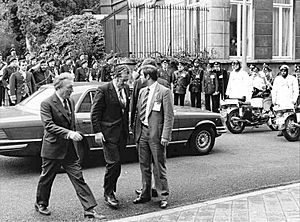
Even though he understood the problem, Haughey's government increased public spending, which made the economic situation worse. This led to more borrowing and higher taxes. In 1981, Haughey decided to call a general election. However, the timing was affected by events like the hunger strikes by IRA volunteers. The election was eventually held in June. Fianna Fáil did not win enough seats to form a majority government. A coalition government was formed by Fine Gael and the Labour Party, led by Garret FitzGerald. Haughey then became the leader of the opposition.
Second Term as Taoiseach (1982)
FitzGerald's government did not last long. It fell apart in January 1982 over a budget proposal. FitzGerald asked President Hillery to call another election. However, Haughey's party tried to convince the President not to call an election and instead allow Fianna Fáil to form a government. President Hillery refused this pressure and called the election.
After the February 1982 election, Haughey still did not win a clear majority. Some in his party questioned his leadership. However, Haughey managed to make agreements with other independent TDs, including Tony Gregory (in a deal known as the Gregory Deal), and the Workers' Party. These agreements allowed him to become Taoiseach for a second time.
Haughey's second term also faced economic challenges. His government eventually collapsed when the Workers' Party and Tony Gregory withdrew their support over proposed spending cuts. Fianna Fáil lost the November 1982 election, and FitzGerald returned as Taoiseach. Haughey was back in opposition.
In August 1982, a situation involving the Attorney General led to a press conference where Haughey described the affair as "grotesque, unbelievable, bizarre and unprecedented." This phrase was shortened by a journalist to the famous term GUBU.
Back in Opposition (1982–1987)
Haughey's leadership was challenged again when a report linked him to a phone tapping incident involving journalists. Despite pressure, Haughey refused to resign and survived another vote of no-confidence in early 1983. After three attempts to remove him, most of his critics gave up.
In 1984, the New Ireland Forum Report was published, which discussed ways to improve the political situation in Northern Ireland. Haughey had been involved in drafting it but later rejected it, saying the only solution was a United Ireland. This caused disagreement within his party. Desmond O'Malley, a critic of Haughey, supported the report and was later expelled from Fianna Fáil for his views.
O'Malley then decided to form a new political party called the Progressive Democrats in 1985. Several Fianna Fáil TDs, including Mary Harney, joined this new party.
In November 1985, the Anglo-Irish Agreement was signed between Taoiseach Garret FitzGerald and British Prime Minister Margaret Thatcher. This agreement gave Ireland a formal say in Northern Ireland's affairs. Haughey strongly criticized the agreement and promised to renegotiate it if he was re-elected.
FitzGerald called a general election in February 1987. The campaign focused on the government's budget cuts and economic management. Haughey's Fianna Fáil did not win an overall majority again. However, when it came to electing a Taoiseach in the Dáil, the independent TD Tony Gregory voted against FitzGerald but did not vote for Haughey. This allowed Haughey to be elected Taoiseach with the deciding vote of the Ceann Comhairle (the speaker of the Dáil).
Final Term as Taoiseach (1987–1992)
Haughey now led a minority Fianna Fáil government. The main opposition party, Fine Gael, led by Alan Dukes, took an unusual step called the Tallaght strategy. They agreed to support the government on tough economic policies to help fix the national debt. The government introduced big budget cuts and changed the tax system to encourage business and jobs. One important project was setting up the International Financial Services Centre (IFSC) in Dublin, which brought many economic benefits.
In 1989, Haughey called another general election, hoping to win a clear majority. However, Fianna Fáil lost seats. For the first time in history, a nominee for Taoiseach failed to get a majority vote in the Dáil. Haughey had to resign but stayed on as acting Taoiseach for a short time. After 27 days, Fianna Fáil formed a coalition government with the Progressive Democrats. This was the first time Fianna Fáil had ever formed a coalition, which was a big change for the party.
In 1990, Haughey faced more challenges. Ireland held the presidency of the European Community. Haughey supported German Reunification, believing Ireland and Germany shared a similar experience of being divided countries.
The presidential election was disappointing for Haughey's party. Their candidate, Brian Lenihan, was defeated by Mary Robinson. During the campaign, a controversy resurfaced about phone calls made to the President in 1982, urging him not to dissolve the Dáil. Lenihan was accused of trying to influence the President. The Progressive Democrats threatened to leave the coalition unless Haughey removed Lenihan. Haughey eventually dismissed Lenihan, which weakened Haughey's position within his own party.
Haughey's hold on power began to slip in late 1991. There were resignations from state companies, and Minister for Finance Albert Reynolds openly said he would run for party leadership if Haughey resigned. Haughey dismissed Reynolds and his supporters from the government and won a no-confidence vote against him.

However, Haughey's victory was short-lived. Seán Doherty, who had taken responsibility for the phone-tapping scandal in the early 1980s, stated on television that Haughey had known about and approved the tapping. Haughey denied this, but the Progressive Democrats said they could no longer be in government with him. Haughey told their leader, Desmond O'Malley, that he would step down soon, wanting to choose his own time.
On 30 January 1992, Haughey resigned as leader of Fianna Fáil. He remained Taoiseach until 11 February 1992, when Albert Reynolds took over. In his final speech to the Dáil, he quoted Othello, saying "I have done the state some service, they know it, no more of that." Haughey then retired from politics at the 1992 general election. His son, Seán Haughey, was elected as a TD in his father's old area.
Later Life and Passing
Charles Haughey had been ill for about ten years. He passed away from prostate cancer on 13 June 2006, at his home in Kinsealy, County Dublin, at the age of 80.
He received a state funeral on 16 June 2006. He was buried in St. Fintan's Cemetery, Sutton in County Dublin. The funeral was broadcast live on television and watched by many people. Important figures like President Mary McAleese and the then Taoiseach, Bertie Ahern, attended.
Legacy
Charles Haughey's life and career have been explored in books and television. A three-part TV drama called Charlie, which covered his time as Taoiseach from 1979 to 1992, was shown on RTÉ in 2015.
Governments Led by Charles Haughey
Charles Haughey led the following governments:
- 16th Government of Ireland (December 1979 – June 1981)
- 18th Government of Ireland (March 1982 – December 1982)
- 20th Government of Ireland (March 1987 – July 1989)
- 21st Government of Ireland (July 1989 – February 1992)
See also
 In Spanish: Charles Haughey para niños
In Spanish: Charles Haughey para niños
- Families in the Oireachtas
- Haughey
- Haughey (TV series)


